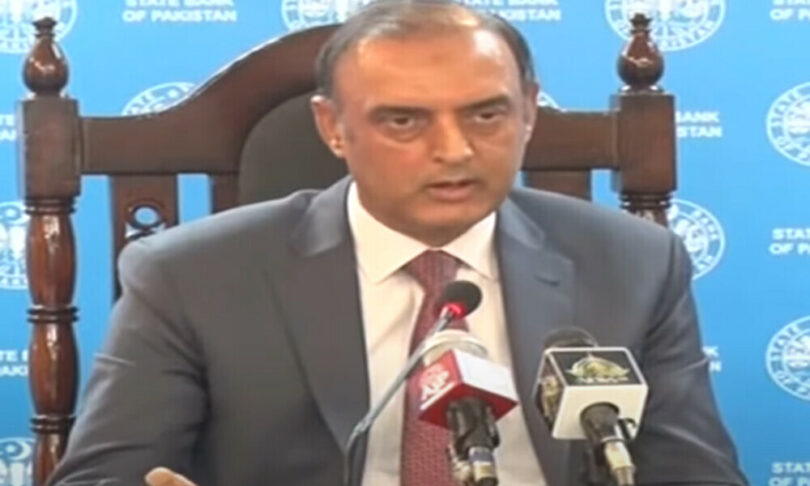F.P. Report
KARACHI: The State Bank of Pakistan’s Monetary Policy Committee (MPC) at its meeting here on Monday decided to keep the policy rate unchanged at 22 percent.
The Committee noted that the economic uncertainty has decreased since the last meeting, whereas near-term external sector challenges have been largely addressed and investor confidence has shown improvement. While some upside risks to the inflation outlook have emerged, the Committee also took note of the expected lagged impact of the accumulated monetary tightening so far, budgeted fiscal consolidation, and the tepid growth outlook for FY24. The MPC particularly noted that year-on-year (y/y) inflation is likely to remain on downward path over the next 12 months, which implies a significant level of positive real interest rate.
Since the MPC meeting held on June 26, several important developments have influenced the short-term macroeconomic outlook. First, Pakistan has secured a nine-month Stand-By Arrangement (SBA) with the IMF that has helped address immediate external sector stability concerns by supporting the foreign exchange reserves.
With disbursement of the first tranche under the SBA and $3 billion in bilateral support, the SBP’s FX reserves increased from $4.5 billion at end June 2023 to $8.2 billion as of July 21, 2023. Second, on top of the additional tax measures introduced at the time of approval of the budget, the government has notified an increase in electricity tariffs which would contribute to inflation in coming months.
Third, the global commodity prices have somewhat increased but are still lower than their recent peak. Fourth, the IMF in its July 2023 World Economic Outlook has slightly raised its projection of global growth this year while leaving the 2024 growth projection unchanged.
In light of these developments, the MPC stressed on maintaining an appropriately tight monetary policy stance with positive real interest rates on forward looking basis to keep inflation and its expectation on downward path so as to achieve the medium-term inflation target of 5 – 7 percent by end-FY25.
The latest high-frequency indicators up to June 2023 continue to show weak economic activity, broadly in line with the provisional estimates of 0.3 percent real GDP growth in FY23; a sharp decline from around 6 percent growth in the previous two years. Looking ahead, barring unforeseen events, the MPC expects economic activity to moderately recover in FY24, supported by a rebound in rice and cotton output. The Committee further noted that improved business confidence and withdrawal of priority guidance on imports have improved the outlook for manufacturing, construction and allied services. Notwithstanding this improvement, the unfolding impact of accumulated monetary tightening and expected fiscal consolidation would continue to keep growth range bound. Taking these considerations into account, the real GDP growth is projected in the range of 2.0 to 3.0 percent for FY24.
With the current account balance recording a surplus for the fourth consecutive month in June, the cumulative current account deficit in FY23 substantially narrowed to 0.7 percent of GDP from 4.7 percent in FY22. The MPC noted that this improvement primarily stems from policy-induced compression in imports, which more than offset the decline in exports and workers’ remittances during the year. Going forward, the current account deficit is expected to remain contained in the range of 0.5 to 1.5 percent of GDP in FY24. This assessment takes into account the impact of evolving domestic and global economic conditions. The MPC expects that current outlook for the global commodity prices along with moderate domestic economic recovery will keep the imports range-bound. On the financing side, the prospects of multilateral and bilateral inflows have considerably improved after the IMF SBA. This is important in the context of building external buffers and meeting the near-term external financing needs. Further, the market-determined exchange rate will continue to serve as first line of defense against external shocks and support reserve build-up.
The latest data indicates that both the fiscal and primary deficits may exceed their revised estimates for FY23. The Committee noted that this less than earlier anticipated fiscal consolidation could undermine the central bank’s efforts to contain inflation and inflation expectations. In this backdrop, the MPC emphasized the importance of achieving the envisaged fiscal consolidation in FY24 in the context of achieving broader macroeconomic stability.
Broad money (M2) growth increased to 14.4 percent in FY23 from 13.6 percent in FY22. This higher M2 growth was mainly driven by increased public sector borrowing, especially budgetary borrowing from the commercial banks amidst reduced foreign inflows. Growth in private sector credit, on the other hand, decelerated substantially, in line with the slowdown in economic activity and tight monetary policy stance. Going forward, improved financing mix after the unlocking of multilateral and bilateral external financing along with some uptick in economic activity would provide space for a moderate expansion in private sector credit this year. This assessment takes into account the lagged impact of monetary tightening on credit up-take and the near-term inflation outlook.
As anticipated, national CPI inflation has moderated considerably from its peak of 38 percent y/y in May 2023 to 29.4 percent in June. The decline was broad-based. Looking ahead, the MPC expects the y/y inflation to remain generally on a downward trajectory due to subdued domestic demand amid tight monetary policy stance, favorable outlook for global commodity prices, and positive base effect. This assessment takes into account the impact of recent measures (increase in electricity tariffs, changes in duties and taxes on consumer items and raw materials) and their second-round effects. Based on this assessment, the MPC projects average inflation in the range of 20 – 22 percent in FY24, down from 29.2 percent in FY23. The MPC’s assessment shows inflation to fall gradually during the first half of FY24, before falling below 20 percent in the second half. This outlook, nevertheless, is subject to risks arising from domestic and external shocks such as adverse climate events, and global commodity price volatility. In this regard, the MPC will continue to carefully monitor the impact of unfolding domestic and global developments on the inflation outlook, and, if required, recalibrate the monetary policy stance to achieve price stability.







